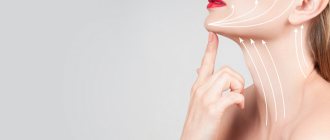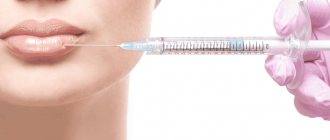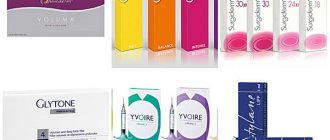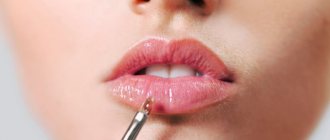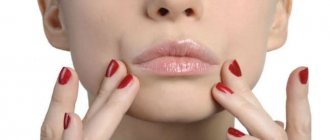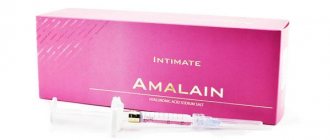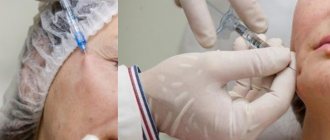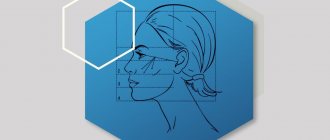One of the most popular aesthetic medicine procedures is “Jolie Cheekbones”. Once upon a time, such beautification cost a lot of money, was carried out only operationally and had nothing to do with the person of Angelina Jolie.
Today this is an ordinary manipulation with the help of fillers , which is in demand both among young ladies and ladies of Balzac age. Among cosmetologists, this procedure is called cheekbone augmentation.
Who is indicated for cheekbone augmentation?
Women intuitively strive for triangular facial harmony. A young face, whatever its shape, is an inverted triangle, with the chin at the top and the forehead at the base.
Cheekbones emphasize the base, both from the front and in profile.
To look young, you need to have clear, accentuated cheekbones!
With age (or anatomically at a young age), cheekbones may become less pronounced and the shape of an even triangle is lost. This is also aggravated by age-related ptosis – drooping of facial tissues. A striking example of pronounced cheekbones was actress A. Jolie.
Direct indications for the procedure are:
- facial asymmetry;
- sunken cheeks;
- soft tissue ptosis;
- nasolabial folds;
- weak cheekbones.
In addition to independently transforming the cheekbone area, cheekbone enlargement allows you to smooth out small nasolabial folds, get rid of eye bags and hollows under the eyes in the lateral areas. The procedure for enlarging the cheekbones is carried out with a needle or cannula using special preparations for facial contouring - fillers.
Photos before and after correction of the zygomatic region
During correction, dense and viscous preparations are used that are able to hold their shape well. The amount of the drug on each side of the face is individual, you can focus on 1-2 ml.
Important! The effect of pronounced cheekbones cannot be achieved with such a “promoted” procedure as “vector lifting!”
The result after the procedure lasts for 9-14 months.
Individual reactions
One of the most common situations is an unpredictable reaction of the body to an injected drug. All people’s bodies are different, and it is impossible to say 100% how a particular organism will react to a particular drug, even if one wants to. A case may arise when ten patients were injected with the drug, and everything was fine, and the eleventh reacted to it with the appearance of edema in the treated area. This can happen even to the most experienced doctor using the highest quality filler. The reaction of tissues to injections is not always predictable. It’s worth taking this into account and being prepared for this scenario.
What to do?
If after the injections you experience any unpleasant symptoms or simply do not feel pleasure from the result obtained, contact your specialist and let him know about it! All shortcomings can be corrected and eliminated.
Cheekbone contouring and thread lifting: differences
Contour plastic and thread lifting are effective methods of non-surgical facial rejuvenation. There is a lot in common between them, but there are also fundamental differences:
- The filler is a gel-like preparation, the threads are a polymer.
- The principle of action of fillers is based on filling tissue volumes; the threads activate collagen production and/or pull tissue up.
- The effects of threads tend to last less.
Unique thread lifting techniques allow you to fix the threads in a position that contributes to the formation of a reliable skin frame and volume in the cheekbone area. However, if you lack volume in the cheekbone area (with age or naturally), then there will simply be nothing for the threads to fix.
Thread methods move tissue, contouring methods with fillers add the necessary volume. In some cases, these methods can be used in combination.
For patients under 30 years of age, preparations based on hyaluronic acid are indicated. After 35, fillers with a higher density are relevant, for example, Radiesse, which does not attract water and does not cause delayed swelling. Most modern drugs are biodegradable and absolutely safe.
Filler rejection
If the patient suffers from an autoimmune disease or has an endocrine pathology, the filler injection procedure itself is a big question for her. Most often, such diseases are a reason for withdrawal from the procedure. Fillers are not recommended for diseases such as lupus, psoriasis, and diabetes. If you make an injection while suffering from a similar disease, various responses from the body are possible - from a severe form of allergy to the formation of seals at the injection site.
What to do?
Before turning to contour plastic surgery, you should undergo a high-quality medical examination and make sure that there are no such diseases. Consider the fact that autoimmune or endocrine diseases do not always produce clear symptoms, so you can live with such a disease for years and not suspect its presence.
How does cheekbone enlargement work?
The procedure for introducing the gel is atraumatic. In our clinic, the filler is injected under the skin with a cannula, which, unlike a needle, carefully pushes the tissue apart and bypasses the vessels. Working with both a needle and a cannula requires the doctor to have impeccable knowledge of anatomy and virtuoso mastery of the subject, so do not agree to correction of the cheekbones from little-known doctors, and especially in “non-clinical” conditions.
The process can be divided into three stages:
- cleansing;
- marking;
- injection of filler.
Preliminary anesthesia is usually not required. Firstly, the process affects deep layers of tissue, where superficial anesthesia does not penetrate. Secondly, many drugs contain lidocaine.
Telephone consultation is always free!
Leave your contact, we will tell you everything and offer a discount!
Send
Thank you!
Information has been sent to the clinic administrators!
Amount of drug
The amount of gel that will be used during contouring is calculated during an in-person consultation. On average, 3 ml of Radiesse and 2-4 ml of filler based on hyaluronic acid are enough for both cheekbones.
The effect lasts from several months to 2 years. How quickly the gel dissolves is primarily influenced by the patient’s age and lifestyle.
“Jolie's cheekbones” are not a cheap pleasure, since correction should be carried out only with high-quality drugs that do not cause delayed complications and do not “migrate” in the tissues over time. The cost of 1 ml of such a drug starts at 17,000 rubles .
Those who want to save money and those who do not care about brands and long-term research should pay attention to inexpensive certified Korean fillers, in particular Neuramis. The results from these drugs last a little less.
Correction of the middle third of the face
Correction of the middle third of the face
Previously, in our articles, we wrote about aging as something general, they say, old age is not joy, everything gets old, but you hold on.
It's time to look at aging more closely - how exactly our face reveals our age. And you need to start from the middle third of the face. What is the middle third of the face?
The middle third of the face is considered to be the area extending from the edge of the eye orbit above and the nasolabial fold to the zygomatic bone on both sides. The smooth, rounded contours of this zone and the volume in 3D projection give the face a youthful appearance. But the flat outlines of this zone, even at a young age, look sad, tired and exhausted.
When a person reaches a certain age, the subcutaneous fat layer of the skin decreases and stretches. When stretched, the skin becomes thinner, which (and also due to gravity) causes overhangs called folds to appear on the face.
We all understand that the average face of the face is always in full view, and it is work with this area that most effectively affects the fight against age-related changes.
The general task of rejuvenation can be divided into four parts, the first is tightening the overhanging cheekbones, then eliminating bags under the eyes, then smoothing out nasolabial folds and, of course, filling the tear trough.
Before rejuvenating the middle third of the face, it is important to understand how it ages. Of course, everyone ages according to their own unique method or nature, simply because they are a bright individual with a certain set of genes, but nevertheless, there are enough common features for everyone.
The average Slavic face begins to age most actively from the middle third of the face. For Asians, by the way, everything is not quite like that, and even the Germans and Scandinavians begin to age from the nasolabial folds, and the Slavs from the cheekbones and eyes.
By and large, the volume of adipose tissue in the middle third of the face plays a key role - with its reduction comes problems: hello to three-dimensional ptosis, which occurs due to a lack of support structures in the middle part of the cheeks.
And now about what we do with all this.
Cosmetological correction of lost volume is carried out using three types of procedures:
- Introduction of fillers based on hyaluronic acid
Today, almost every cosmetology office, and even more so a plastic surgery clinic, offers this procedure for facial correction in its range of services. For relatively little money, you can effectively get rid of wrinkles and folds, correct the shape of your face, and generally refresh your skin by introducing fillers based on hyaluronic acid. Today, stabilized hyaluronic acid is in use, since it is not rejected by the body, and the effect does not take long to appear.
There are two types of hyaluronic acid fillers: monophasic and biphasic.
Actually, when we say monophasic or biphasic, we are talking about a gel-like preparation that is used during the procedure. Monophasic consists of molecules and microscopic particles are evenly distributed under the skin, and after a relatively short time they are quickly eliminated from the body due to metabolism, without consequences for the body.
Well, biphasic ones solve more complex problems. They are not as flexible as monophasic ones, but are well distributed deep under the skin. Therefore, they are introduced where deep correction is necessary. The period of biodegradation of biphasic gels is much longer.
We have already discussed the mechanics of filler injection. It's simple: with a thin needle, the filler is injected under the skin in the problem area of the face.
- Introduction of fillers based on calcium hydroxyapatite
Calcium hydroxyapatite is an inorganic component of human bone tissue. That is, calcium hydroxyapatite is not alien to the human body. It can be found in bones and tooth enamel. Consequently, calcium hydroxyapatite is absolutely safe for humans and can be used in medicine without hesitation.
If you believe the manufacturers (and we not only believe, but have already been convinced of this many times), then calcium hydroxyapatite stimulates collagen synthesis in the skin. But collagen synthesis is exactly what you need, especially after 25.
With such characteristics, calcium hydroxyapatite is usually used specifically against wrinkles. The drug Radiesse, which contains calcium hydroxyapatite, has become widespread.
- Thread lifting
Thread lifting always takes place under local anesthesia. Using a microscopic puncture in the temple area, the thread is inserted into problem areas. Next, the thread enters the facial tissue through the needle channel. Due to its structure, the thread “clings” to the tissue; this property is used in this type of correction. The thread is pulled in the opposite direction and the skin is stretched. The procedure for correcting the middle third of the face using thread lifting does not leave any scars. The entry and exit points of the thread are very small and quickly tighten without a trace, and the skin did not receive any other external damage.
In conclusion, I would like to make a note that hyaluronic acid, which is used to correct the middle third of the face, is used for a short period of time, from six months to a year. For people prone to swelling, it is better to choose a different type of correction. The drug Radiesse, with calcium hydroxyapatite, can “work” for up to three years. As for threads, this is the best option for tightening the skin in the cheekbone area.
You can find out more about the procedure for correction of the middle third of the face in our Cleo-Line clinic in Moscow.
Fillers dissolve quickly
The shapes obtained using contour plastic surgery are preserved on average for a period of six months to one and a half years. The exact period depends on the individual characteristics of the body, as well as on compliance with recommendations during the recovery period and beyond. If your own fat was used as an injection, the result can last for several years. But it should be borne in mind that immediately after injection, from a third to a half of the entire injected volume of fat cells can be absorbed, and this result is considered normal.
